상세정보
하늘을 향해 차오르는 새들과 아득히 펼쳐진 산수에서의 감동과 안락감을 느끼고, 그 안에 담긴 봄처럼 따듯한 인간애가 느껴지는 전시
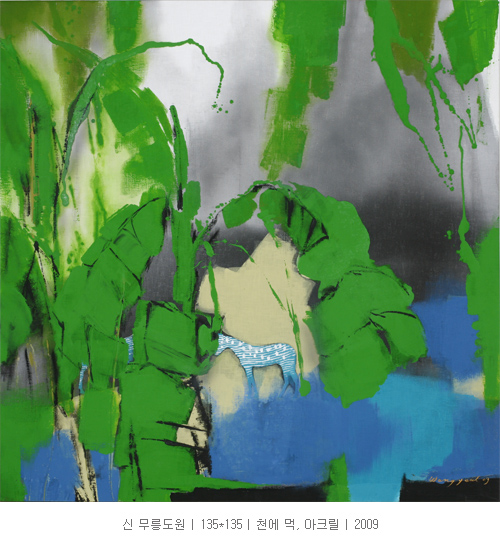 봄-무릉도원을 가다
봄-무릉도원을 가다 왕 열 (王 烈)
무릉도원武陵桃源의 일상을 현대인들의 쉼터로 제공 하는 이번 38회 전시는 따스한 봄날의 정취를 배경으로 담고 있다. 바쁜 일정 속에서 즐거운 사색과 화려한 시각적 유희를 바라는 마음으로 작품 제작 중에도 즐겁고 유쾌한 마음으로 제작하려고 부단히 노력 했다.
예술 작품은 영혼에 의하여, 영혼을 위하여 창조되어야 하며 영혼을 표현하고 영혼에 자양을 주고 영혼을 풍부하게 해주는 것이 되어야 한다. 그러기 위하여 무릉도원의 여행을 테마로 하였다.
무릉도원武陵桃源은 동진東晉때의 시인 도잠陶潛:자는 淵明의 《도화원기桃花源記》에 나오는 이야기이다. 어느 날 한 어 떠내려 오는데 향기롭기 그지없었다. 향기에 취해 꽃잎을 따라가다 보니 문득 앞에 커다란 산이 가로막고 있는데, 양쪽으로 복숭아꽃이 만발하였다.
수백 보에 걸치는 거리를 복숭아꽃이 춤추며 나는 가운데 자세히 보니 계곡 밑으로 작은 동굴이 뚫려 있었다. 그 동굴은 어른 한 명이 겨우 들어갈 정도의 크기였는데, 안으로 들어갈수록 조금씩 넓어지더니, 별안간 확 트인 밝은 세상이 나타났다.
그곳에는 끝없이 너른 땅과 기름진 논밭, 풍요로운 마을과 뽕나무, 대나무밭 등 이 세상 어느 곳에서도 볼 수 없는 아름다운 풍경이 펼쳐져 있었다. 두리번거리고 있는 어부에게 그곳 사람들이 다가왔다. 그들은 이 세상 사람들과는 다른 옷을 입고 있었으며, 얼굴에 모두 미소를 띠고 있었다. 어부가 그들에게 궁금한 것을 묻자, 그들은 이렇게 대답했다.
"우리는 조상들이 진秦나라 때 난리를 피해 식구와 함께 이곳으로 온 이후로 한번도 이곳을 떠난 적이 없습니다. 지금이 어떤 세상입니까?" 어부는 그들의 궁금증을 풀어 주고 융숭한 대접을 받으며 며칠간을 머물렀다. 어부가 그곳을 떠나려 할 때 그들은 당부의 말을 하였다. "우리 마을 이야기는 다른 사람에게 하지 말아 주십시오."
그러나 어부는 너무 신기한 나머지 길목마다 표시를 하고 돌아와서는 즉시 고을 태수에게 사실을 고하였다. 태수는 기이하게 여기고, 사람을 시켜 그 곳을 찾으려 했으나 표시해 놓은 것이 없어져 찾을 수 없었다. 그 후 유자기라는 고사(高士)가 이 말을 듣고 그곳을 찾으려 갖은 애를 썼으나 찾지 못하고 병들어 죽었다. 이후로 사람들은 그곳을 찾으려 하지 않고, 도원경은 이야기로만 전해진다.
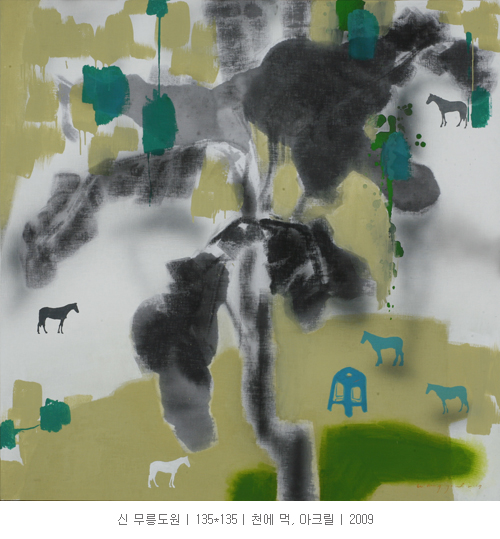
서양의 유토피아란 원래 없는ou 장소toppos라는 의미이다.
도연명도 이상향으로 도원경을 그리며 인간이 찾을 수 없는 곳이라 말하고 있다. 무릉도원이라고도 한다. 이곳은 현대인들의 마음의 안식처인 것이다.
이제까지 많은 시대, 많은 작가들이 나름의 유토피아를 구현해냈는데, 그것은 항상 못마땅한 ‘이 세계’와 반대되는 모습이었다. 배고픔이 지배하던 시절의 유토피아는 먹을 것이 지천에 넘쳐나는 곳이었고, 기계문명에 염증을 느낀 자가 그려내는 유토피아는 자연의 섭리가 지배하는 곳이다. 그러나 그렇게 구현되어 제시된 유토피아들은 허구에 불과하다. 유토피아란 없는-곳이기 때문이다.
유토피아를 꾸며내어 거기에 의탁하지 않고, 진정한 유토피아 곧 ‘없는 곳’을 통해 ‘이 삶’을 돌아보고 즐거움을 누려볼 생각이다. 이는 진정한 마음의 즐거움이다.
이러한 그림에 마음을 담기 위해서는 그리는 대상의 형상보다 화가의 의지가 더 중요 하다는 것은 다 알고 있는 사항이며, 자기수련과 상통하는 내용이다. 베토벤이 귀가 먼 일에 비유할 수 도 있을 것이다. 그것은 바로 이미 손에 익을 대로 익은 기교를 빌어 내면 깊숙한 곳의 음악을 펼쳐내어 이를 예술적인 경지로 승화시킨 것을 말하는 것이다.
오직 눈에 보이는 것에만 의존하고 정신을 게을리 하는 것은 형태의 피상적인 것만 보고 그리는 것에 그치는 일이다. 형태의 진정한 인식을 획득하려면 우리의 영혼의 빛으로 만물을 비추어야 하며, 보이는 사물과 보이지 않는 사물에서 발하는 빛을 받아들일 준비가 되어 있어야 한다.
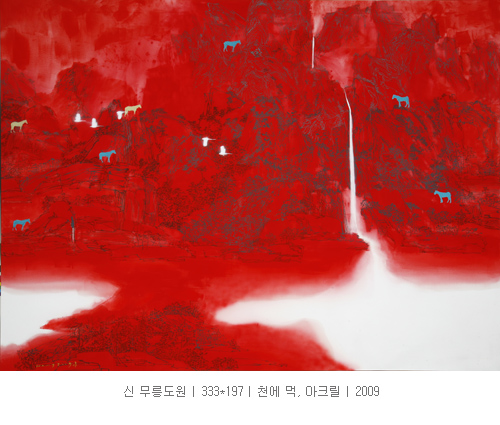
<봄-무릉도원을 가다 >전시의 소재들은 풍경과 같은 부류로 이해하기 쉽지만 그것은 외연적인 것이고 내포는 새와 자연을 통하여 도시 생활 속에서 살아가는 인간들의 고독과 동행 그리고 행복 등 다양한 희노애락의 삶을 은유적 표현인 것이다. 여기서 ‘새’는 사람을 상징화시켜 의인화한 것이며 그 배경의 자연들은 도시풍경인 것이다. 새는 외롭게 혼자 있기도 하고, 여러 마리가 나타나기도 하는데 인간의 다양한 삶의 모습이 함축되어 있는 것이다. 새와 말 그리고 파초 는 작가 자신을 포함한 모든 인간의 실존적인 모습이자, 자유로운 여행과 조용한 침묵속의 휴식을 즐기며 이상세계로 나아가고자 하는 의지의 반영이다.
자연과 산수를 묘사하면서 형태나 조형성에 앞서 정신과 사유를 우선에 두고 있다.
아득히 멀리선 무릉도원의 자연과 이를 관조하는 자아, 그리고 관람객의 관계적 설정은 옛 문인들이 그리던 산수화의 전형적인 심상이다.
인간의 삶이 내재하고 있는 곤궁과 실존적 고통들을 직시하는 한편 이를 낙관적 자세로 극복하고자 하는 의지를 담아내고자 하였다.
이번 전시를 통해 하늘을 향해 차오르는 새들과 아득히 펼쳐진 산수에서의 감동과 안락감을 느끼고, 그 안에 담긴 봄처럼 따듯한 인간애를 느끼는 전시가 되길 기대한다.
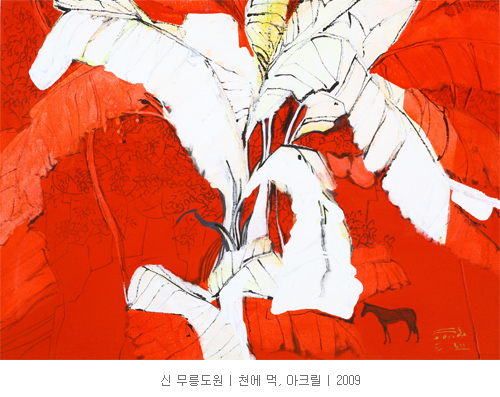
A Spring Journey to Mureung-dowonBy Wang Yeul
This is the 38thexhibition for modern people to experience the daily aspects of Mureung-dowon, a paradise of a peach garden as a place to relax with a warm spring mood. With the hopes that modern people can enjoy pleasurable contemplation, and visual amusement through this exhibition, I have gone to great efforts to create work from a cheerful, delightful mindset.
A work of art should be created for the soul by the soul, and should represent, nurture, and enrich the soul.
The theme of this exhibition is the journey to Mureung-dowon.A short but intriguing description of this legendary garden appears in Taohuayuanqi, or Tale of Peach Blossom Land by Tao Qian (whose penname is Yuanming), an Eastern Jin Chinese poet. One day a flower leaf that is fragrant beyond description floated down. Intoxicated with this scent, a fisherman followed it, but an enormous mountain blocked his way. Peach blossoms are in full bloom in its both sides. After walking hundreds of steps, he discovered a small cave in the valley. The cave was so narrow that he is barely able to squeeze through. The cave became wider the farther he entered it. A bright world suddenly appeared before his eyes. An indescribably beautiful world with borderless plains, fertile fields, a peaceful hamlet, mulberry and bamboo tree gardens unfolded before him.
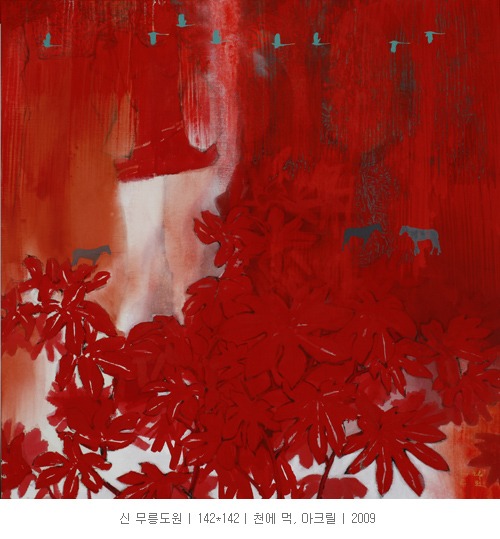
The people there approached him while he was wondering where to go. They were all dressed in different clothes than those of his world and all wore smiles. When the fisherman asked they replied: "We came here with our family in the Jin Dynasty to seek shelter from wars. Since then, we have never left. What happens now in the outside world?" The fisherman satisfied their curiosity and received warm hospitability during the few days he stayed there. When the man was about to leave, they asked him not to tell others about his world. However, the fisherman marked the path to return again, as it was such a curious place. Immediately after returning, he reported to the viceroy of his town about the place. The viceroy ordered the place be sought out, but no one could find the way, for all the marks had disappeared. A hermit Liuzizi made all efforts to look for the place, but fell ill and died without finding it. No one has tried looking since. This legendary land has been passed down just as a tale.
The word utopia comes from Greek ‘ou’ referring to ‘not’ and ‘topos’ meaning ‘place’. Tao Yuanming described the peach blossom land, or Mureung-dowon as the place we cannot find. It is also called Mureung-dowon, a haven for the mind. Many utopias embodied by numerous artists are always opposed to this world. In the ages of starvation, a utopia was depicted as a place abundantwith things to eat, while for those fed up with industrialized civilization, a utopia is the place governedby the providence of nature. These utopias are pure fiction because utopia is the place that does not exist.
I intend to look back on life in this world through the depiction of a true utopia, namely non-existent places, enjoying my own pleasures. This is the enjoyment of the mind.
An artist’s will is more important than the form of an object encapsulated in the mind. This is in line with self-practice. As Beethoven did, it is like raising one’s technique to the level of an art, unfolding something deep in one’s mind. Relying merely on our eyes draws out something superficial, not spiritual. To truly perceive form, we have to shine ‘Ten Thousand Things’ with the light of the soul and embrace the lights from both the visible and invisible.
Works on display at this show can be understood as landscapes, but it is a superficial classification. Through nature like the bird, they virtually represent a variety of aspects of urban life such ashuman solitude, companionship, and happiness in a metaphorical manner. This bird is a symbolic, personified image of a man and the nature in its background is an urban scene. A bird or a group of birds that appear in these works are connotations of diverse aspects of human life. The bird, horse, and plantain are existential appearance of all humans including myself and a reflection of my will to go ahead toward an ideal world through a liberal journey.
While depicting nature such as mountains and waters, I put first priority on spirit and thought rather than form and composition. The relationships between nature, the self meditating it at a distance, and viewers were the typical setting of an old literati landscape painting. I intend to capture the existential pain and hardship innate in human life and my will to overcome them with an optimistic attitude.
I expect through this exhibition viewers feel the impression and comfort in the birds soaring toward the sky and the dimly spread landscapes as well as warmhearted humanity like spring.





